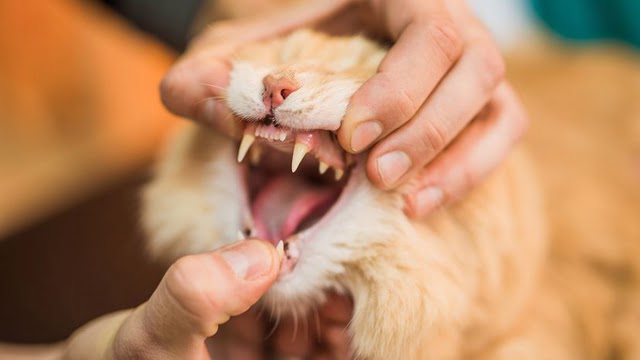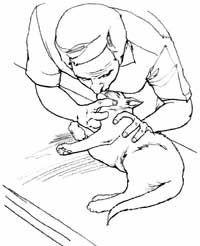Quck answer
If your cat is choking, it’s important to act quickly to save their life. Follow these steps:
1. Stay calm and approach your cat slowly.
2. Check their mouth and throat for any foreign objects or obstructions. If you see something, try to remove it with your fingers or tweezers, being careful not to push it further in.
3. If you can’t remove the object, perform the Heimlich maneuver by placing your hands on either side of your cat’s ribcage and squeezing gently but firmly.
4. If the object still won’t come out, take your cat to the vet immediately.
Remember, prevention is key. Keep small objects out of your cat’s reach and be mindful of what they’re playing with. If your cat is prone to choking, talk to your vet about steps you can take to prevent it from happening in the future.
Pets

If you suspect that your cat is choking, it’s crucial to act fast and clear their airway. DjelicS/Getty Images
Choking can be a life-threatening situation for cats. The more a choking cat struggles to breathe, the more panicked and distressed they become. The goal of a cat owner is to open the airway without getting bitten.
If you’re unsure whether your cat is choking, some signs to look for include pawing at their mouth, a blue or pale tongue, obvious distress, and unconsciousness. If your cat is choking, follow these steps to help them.
Step 1: Approach your cat carefully. If they’re nervous or anxious, restrain them if necessary.
Step 2: Clear your cat’s airway.
Step 2a: Place one hand over your cat’s head so that your thumb and index finger fall behind their long canines (fang teeth), and the head rests against your palm. If your cat is struggling too much, move to Step 2e.
Step 2b: Gently tilt your cat’s head back so that their nose is pointing upwards. Push your thumb towards your finger to open their mouth.
Step 2c: Gently pull your cat’s tongue out. If you can see the object, try to remove it with your fingers or needle-nose pliers (unless the object is a needle).
Step 2d: If the object is a needle and embedded deeply in the roof of the mouth, stop. Transport your cat immediately to the veterinarian and keep their tongue gently pulled out of their mouth if they’re in distress.
Step 2e: If you can’t remove the object (other than a needle), pick up your cat by grasping their back legs, turn them upside down, and shake them vigorously. Slapping their back while shaking may help dislodge the object.
Step 2f: If the object is still not dislodged, lay your cat on its side, place your palms behind the last rib on both sides of the abdomen, and press your palms together quickly three or four times. If the object is still caught, repeat this procedure.
Step 3: If you can’t dislodge the object, transport your cat to the veterinarian immediately.
Step 4: If you dislodge the object but your cat is not breathing, feel for a heartbeat by placing your fingers about one inch behind their elbow and in the center of their chest.

В©2006 Publications International, Ltd. Step 5b
Artificial Respiration for a Cat
Step 5: If your cat’s heart is not beating, proceed to Step 6. If it is beating, perform artificial respiration.
Step 5a: Turn your cat onto its side.
Step 5b: Extend their head and neck. Hold their mouth and lips closed and blow firmly into their nostrils. Administer one breath every three to five seconds. Repeat until you feel resistance or see the chest rise.
Step 5c: After ten seconds, stop. Watch the chest for movement to indicate that your cat is breathing on its own.
Step 5d: If your cat is still not breathing, continue artificial respiration.
Step 5e: Transport your cat to the veterinarian immediately and continue artificial respiration on the way to the veterinarian or until your cat is breathing without assistance.
Cardiopulmonary Resuscitation for a Cat
Step 6: If your cat’s heart is not beating, perform cardiopulmonary resuscitation (CPR).
To perform CPR on a cat, follow these steps. First, turn the cat on its side and kneel down at the head of the cat. Then, grasp the chest so that the cat’s breastbone is resting in the palm of your hand, your thumb on one side of the chest and your fingers on the other. Compress the chest by firmly squeezing your thumb and fingers together, striving for 100 to 160 compressions per minute. After 30 seconds, alternately hold the cat’s mouth and lips closed and blow firmly into its nostrils, repeating until you feel resistance or see the chest rise. After one minute, stop and check for breathing movement and the cat’s heartbeat. If necessary, continue CPR until the cat’s heart is beating without assistance. Finally, transport the cat to the veterinarian immediately, continuing CPR or artificial respiration on the way if needed.
FAQ
1. What are the signs of a choking cat?
The signs of a choking cat include difficulty breathing, coughing, gagging, drooling, pawing at the mouth, and blue or pale gums. If you notice any of these symptoms, you should act quickly to help your cat.
2. What should I do if my cat is choking?
If your cat is choking, you should first try to remove the object causing the blockage. If you can see the object and it is within reach, carefully try to remove it with your fingers or a pair of tweezers. If you cannot remove the object, or if your cat is still choking after removing the object, take your cat to the vet immediately.
3. Can I perform the Heimlich maneuver on my cat?
No, the Heimlich maneuver is not recommended for cats as it can cause more harm than good. Instead, try to remove the object causing the blockage with your fingers or tweezers, or take your cat to the vet for help.
4. How can I prevent my cat from choking?
You can prevent your cat from choking by making sure they do not have access to small objects or toys that they could swallow. Keep small items out of reach and supervise your cat when they are playing with toys or eating. Switch to softer food if your cat has a history of choking on dry kibble.
5. Can a hairball cause my cat to choke?
Yes, a hairball can cause your cat to choke. If your cat is coughing and gagging and you suspect a hairball, you can try giving them a hairball remedy or gently brushing their fur to help remove loose hair. If the symptoms persist, take your cat to the vet for further examination.
6. What should I do if my cat is unconscious after choking?
If your cat is unconscious after choking, you should immediately perform CPR and take your cat to the vet as soon as possible. If you do not know how to perform CPR, ask your vet to show you how to do it properly.
7. How can I tell if my cat has swallowed something dangerous?
If your cat has swallowed something dangerous, they may exhibit symptoms such as vomiting, diarrhea, lethargy, loss of appetite, and difficulty breathing. If you suspect your cat has ingested something harmful, take them to the vet immediately.
8. What should I do if my cat is choking and there is no vet nearby?
If your cat is choking and there is no vet nearby, you can try to remove the object causing the blockage with your fingers or tweezers. You can also try performing the Heimlich maneuver if you know how to do it properly. If these methods do not work, try to get your cat to the vet as soon as possible.





Leave a Reply